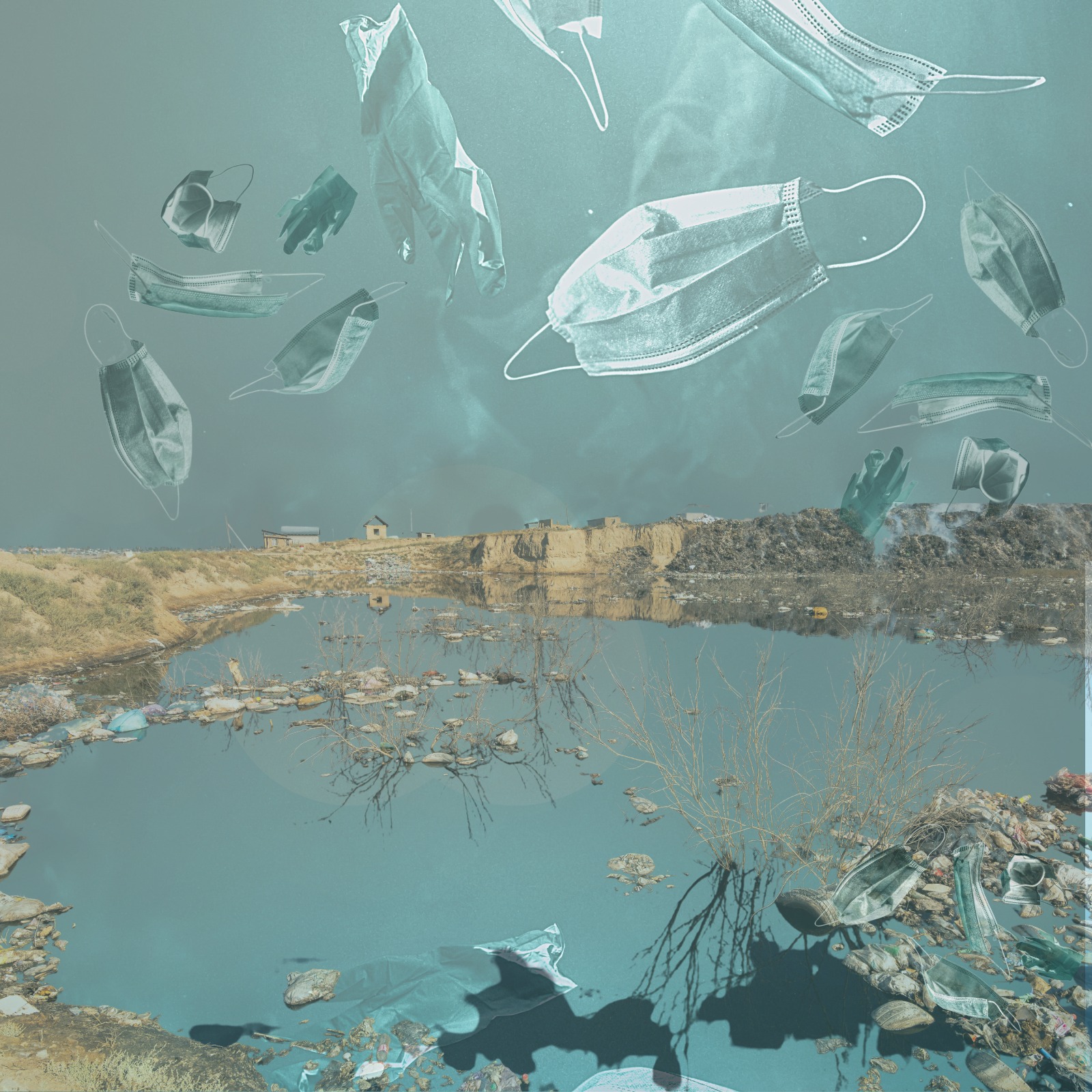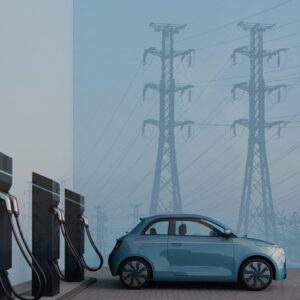
By Mohsin Khan
Edited by Alejandro J. Ramos and Muhammad Hani Ahsan
Graphic by Norie Wright and Arsh Naseer
The COVID-19 pandemic has had severe impacts on the economy, society, and our way of living. The public health crisis and government responses led to a contraction of economic growth, domestic and international trade, and human mobility. Yet, the pandemic brought a positive impact on the environment.1 Some scientists and policymakers suggest that there is a 30% reduction in Greenhouse Gas Emissions on account of the lower domestic and international trade, low transportation, and closure of industries.2 Other research showed that the levels of the pollutant nitric dioxide lowered drastically, by 20–40%, across the United States, China, and Western Europe. While the halting of socio-economic activity during the pandemic positively impacted the environment, the effects are not necessarily permanent and climate action is urgently needed to address the climate crisis.3 Yet, many argue for postponing climate action, and expanding industrial production through carbon-intensive packages—“allowing countries to reduce taxation on carbon emissions to support their economic growth”. The expectation is that delaying regulation and taxation associated with climate policies will allow a smoother recovery, reduce the pressures on public budgets, and tackle unemployment caused by the pandemic.
However, these scientific claims and propositions are shortsighted and have severe implications for climate and environmental policies in developing countries.4 These recovery packages can further entrench developing countries’ dependence on fossil fuels, consequently increasing Greenhouse Gas emissions by 16.4% in 2024.5 Recent research in Germany also shows an increasing trend of the emissions of carbon monoxide (CO), nitrogen oxides (NO and NO2), and carbon dioxide (CO2) across the United States, Canada, Japan, Germany, United Kingdom, France, Italy, Brazil, and India during the pandemic.6 The country-level results reported that Japan has a higher average value in the Economic Activity Index and a higher average value in carbon monoxide (CO) emissions followed by the United States. The higher emissions of pollutants have been the result of an increase in gasoline consumption by the public—as people tend to avoid public transportation and increase the usage of personal vehicles—research further revealed.7
The pandemic affected land and water resources—by increased usage of mass disinfection materials i.e. hand sanitizers, soaps, and bleach having toxic chemicals (i.e. isopropanol, ethanol, sodium hypochlorite, hypochlorous acids, and chlorine), which also harm the aquatic life.8 Similarly, such chemical containments are difficult to degrade and pollute the environment.9 In addition, during the pandemic, the production and demand of non-degradable masks and plastic products (i.e. personal protection equipment-PPE) increased by 40 percent among households and hospitals.10 There was a particular rise in online and takeaway food deliveries from restaurants11, resulting in huge solid wastage—further contaminating the environment. In a survey by Snap in the UK, 60 percent of 18-24-year-olds increased the frequency of delivery services amidst the lockdown.12 Likewise, only in Wuhan City in China, 240 tons of additional medical plastic waste per day is produced13, which is an additional environmental challenge for the communities and local authorities. Another study14 shows that the pandemic restrictions reduced the work of conservationists and wildlife organizations that care for wildlife and protected areas. During the pandemic, reduced conservation efforts were a global trend15, making it hard for the staff of preserves, game parks, sanctuaries, and other wildlife facilities to perform their normal activities.
These negative impacts suggest an increasing interplay between the pandemic, the economy, and the environment. Decision-makers need to consider the interconnected and cohesive dynamics between these complex systems while sketching ways out of the pandemic. While the crises have many more direct and indirect consequences, which will be realized in the coming years, what is evident even in the short-term is to work out how we can play a part in protecting the environment, which is currently balancing itself on a knife’s edge. As the COVID-19 restrictions loosened and economic activities recovered, the need to engage all levels of government, businesses, and communities globally to promote sustainable and eco-friendly policies became clear. Industries and public transportation must reduce dependency on fossil fuels by transitioning to renewable energy resources (i.e. wind, solar). Improving regulatory measures on solid waste management systems to control the pandemic’s effluent and raising awareness among people about pandemic-related pollution is essential. Finally, governments must engage with international organizations such as the United Nations Environmental Program (UNEP) and others to fight against environmental degradation in the aftermath of the global pandemic.
Bio: Mohsin is a Ph.D. Sociology (Development Studies) graduate from the College of Humanities and Development Studies, CAU China. He is also a Development Policy Fellow at KDI School of Public Policy & Management South Korea and a Research Affiliate & Ph.D. Public Policy Candidate at Northeastern University, United States. Throughout his career, he has worked with government, universities, and non-profit organizations, including KOICA M/O Foreign Affairs, DFID, USAID, and CIVICUS-World Alliance for Citizen Participation across Asia and Africa, to implement large-scale development aid projects and evaluate the impact of donor funding aid programs. Read more about the author here.
- Saadat, Saeida, Deepak Rawtani, and Chaudhery Mustansar Hussain. 2020. “Environmental perspective of COVID-19.” Science of The Total Environment.
- Muhammad, Sulaman, Xingle Long, and Muhammad Salman. 2020. “COVID-19 pandemic and environmental pollution: A blessing in disguise?” The Science of The Total Environment 1-5.
- Bauwens, M., S. Compernolle, T. Stavrakou, J-F. Müller, J. van Gent, H. Eskes, P. F. Levelt, et al. 2020. “Impact of Coronavirus Outbreak on NO2 Pollution Assessed Using TROPOMI and OMI Observations.” Geophysical Research Letters 1-9.
- Ankit, Amit Kumar, Vartika Jain, Ankit Deovanshi, Ayush Lepcha, Chandan Das, Kuldeep Bauddh, and Sudhakar Srivastava. 2021. “Environmental impact of COVID-19 pandemic: more negatives than positives.” Environmental Sustainability 447–454.
- Shan, Yuli, Jiamin Ou, Daoping Wang, Zhao Zeng, Shaohui Zhang, Dabo Guan, and Klaus Hubacek. 2021. “Impacts of COVID-19 and fiscal stimuli on global emissions and the Paris Agreement.” Nature Climate Change 200-206.
- Oduniyi, Oluwaseun Samuel, John Riveros, Sherif Maher Hassan, and Ferhat Citak. 2021. “Believe It Or Not: Covid 19 Environmental Effects Are More Negatives Than Positives.” MSR Working Papers.
- Ibid
- Muhammad, Sulaman, Xingle Long, and Muhammad Salman. 2020. “COVID-19 pandemic and environmental pollution: A blessing in disguise?” The Science of The Total Environment 1-5.
- Chalew, Talia E. A, and Rolf U. Halden. 2009. “ENVIRONMENTAL EXPOSURE OF AQUATIC AND TERRESTRIALBIOTA TO TRICLOSAN AND TRICLOCARBAN.” Journal of the American Water Resources Association (JAWRA) 4-13.
- Prata, Joana C., Ana LP Silva, Tony R. Walker, Armando C. Duarte, and Teresa Rocha-Santos. 2020. “COVID-19 Pandemic Repercussions on the Use and Management of Plastics.” Environmental Science & Technology.
- Statista. 2020. Share of people who plan to increase their use of food delivery services due to the coronavirus (COVID-19) pandemic in Great Britain in March 2020, by age. March. https://www.statista.com/statistics/1107212/covid-19-food-delivery-frequency-in-great-britain/.
- Ibid
- The Verge. 2020. The COVID-19 pandemic is generating tons of medical waste. March 26. https://www.theverge.com/2020/3/26/21194647/the-covid-19-pandemic-is-generating-tons-of-medical-waste.
- Manenti, R, E Mori, V Di Canio, S Mercurio, M Picone, M Caffi, M Brambilla, GF Ficetola, and D Rubolini. 2020. “The good, the bad and the ugly of COVID-19 lockdown effects on wildlife conservation: Insights from the first European locked down country.” Biological Conservation.
- IUNC. 2020. Conserving Nature in a time of crisis: Protected Areas and COVID-19. May 25. https://www.iucn.org/news/world-commission-protected-areas/202005/conserving-nature-a-time-crisis-protected-areas-and-covid-19.






Terrific piece, thank you. Prof. Jamy Madeja, Northeastern School of Law